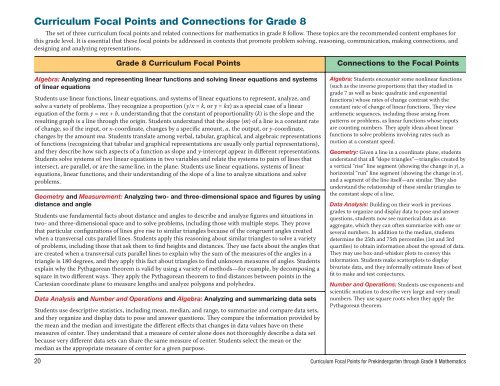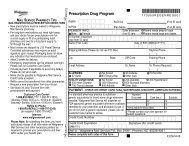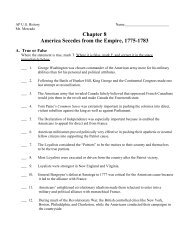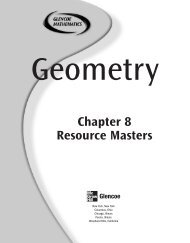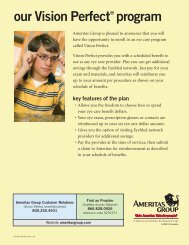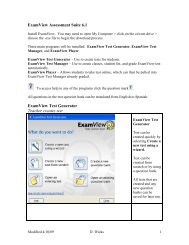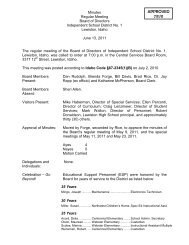Curriculum Focal Points
Curriculum Focal Points
Curriculum Focal Points
Create successful ePaper yourself
Turn your PDF publications into a flip-book with our unique Google optimized e-Paper software.
<strong>Curriculum</strong> <strong>Focal</strong> <strong>Points</strong> and Connections for Grade 8<br />
The set of three curriculum focal points and related connections for mathematics in grade 8 follow. These topics are the recommended content emphases for<br />
this grade level. It is essential that these focal points be addressed in contexts that promote problem solving, reasoning, communication, making connections, and<br />
designing and analyzing representations.<br />
Grade 8 <strong>Curriculum</strong> <strong>Focal</strong> <strong>Points</strong><br />
Algebra: Analyzing and representing linear functions and solving linear equations and systems<br />
of linear equations<br />
Students use linear functions, linear equations, and systems of linear equations to represent, analyze, and<br />
solve a variety of problems. They recognize a proportion (y/x = k, or y = kx) as a special case of a linear<br />
equation of the form y = mx + b, understanding that the constant of proportionality (k) is the slope and the<br />
resulting graph is a line through the origin. Students understand that the slope (m) of a line is a constant rate<br />
of change, so if the input, or x-coordinate, changes by a specific amount, a, the output, or y-coordinate,<br />
changes by the amount ma. Students translate among verbal, tabular, graphical, and algebraic representations<br />
of functions (recognizing that tabular and graphical representations are usually only partial representations),<br />
and they describe how such aspects of a function as slope and y-intercept appear in different representations.<br />
Students solve systems of two linear equations in two variables and relate the systems to pairs of lines that<br />
intersect, are parallel, or are the same line, in the plane. Students use linear equations, systems of linear<br />
equations, linear functions, and their understanding of the slope of a line to analyze situations and solve<br />
problems.<br />
Geometry and Measurement: Analyzing two- and three-dimensional space and figures by using<br />
distance and angle<br />
Students use fundamental facts about distance and angles to describe and analyze figures and situations in<br />
two- and three-dimensional space and to solve problems, including those with multiple steps. They prove<br />
that particular configurations of lines give rise to similar triangles because of the congruent angles created<br />
when a transversal cuts parallel lines. Students apply this reasoning about similar triangles to solve a variety<br />
of problems, including those that ask them to find heights and distances. They use facts about the angles that<br />
are created when a transversal cuts parallel lines to explain why the sum of the measures of the angles in a<br />
triangle is 180 degrees, and they apply this fact about triangles to find unknown measures of angles. Students<br />
explain why the Pythagorean theorem is valid by using a variety of methods—for example, by decomposing a<br />
square in two different ways. They apply the Pythagorean theorem to find distances between points in the<br />
Cartesian coordinate plane to measure lengths and analyze polygons and polyhedra.<br />
Data Analysis and Number and Operations and Algebra: Analyzing and summarizing data sets<br />
Students use descriptive statistics, including mean, median, and range, to summarize and compare data sets,<br />
and they organize and display data to pose and answer questions. They compare the information provided by<br />
the mean and the median and investigate the different effects that changes in data values have on these<br />
measures of center. They understand that a measure of center alone does not thoroughly describe a data set<br />
because very different data sets can share the same measure of center. Students select the mean or the<br />
median as the appropriate measure of center for a given purpose.<br />
Connections to the <strong>Focal</strong> <strong>Points</strong><br />
Algebra: Students encounter some nonlinear functions<br />
(such as the inverse proportions that they studied in<br />
grade 7 as well as basic quadratic and exponential<br />
functions) whose rates of change contrast with the<br />
constant rate of change of linear functions. They view<br />
arithmetic sequences, including those arising from<br />
patterns or problems, as linear functions whose inputs<br />
are counting numbers. They apply ideas about linear<br />
functions to solve problems involving rates such as<br />
motion at a constant speed.<br />
Geometry: Given a line in a coordinate plane, students<br />
understand that all “slope triangles”—triangles created by<br />
a vertical “rise” line segment (showing the change in y), a<br />
horizontal “run” line segment (showing the change in x),<br />
and a segment of the line itself—are similar. They also<br />
understand the relationship of these similar triangles to<br />
the constant slope of a line.<br />
Data Analysis: Building on their work in previous<br />
grades to organize and display data to pose and answer<br />
questions, students now see numerical data as an<br />
aggregate, which they can often summarize with one or<br />
several numbers. In addition to the median, students<br />
determine the 25th and 75th percentiles (1st and 3rd<br />
quartiles) to obtain information about the spread of data.<br />
They may use box-and-whisker plots to convey this<br />
information. Students make scatterplots to display<br />
bivariate data, and they informally estimate lines of best<br />
fit to make and test conjectures.<br />
Number and Operations: Students use exponents and<br />
scientific notation to describe very large and very small<br />
numbers. They use square roots when they apply the<br />
Pythagorean theorem.<br />
20 <strong>Curriculum</strong> <strong>Focal</strong> <strong>Points</strong> for Prekindergarten through Grade 8 Mathematics


